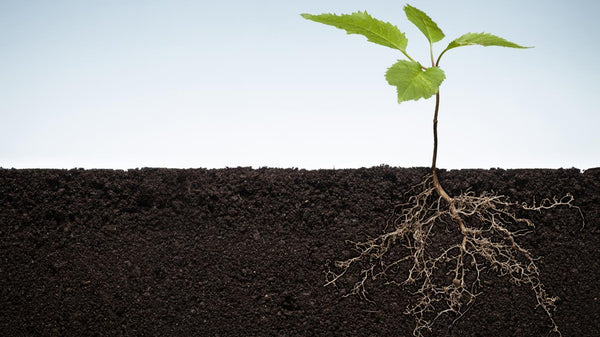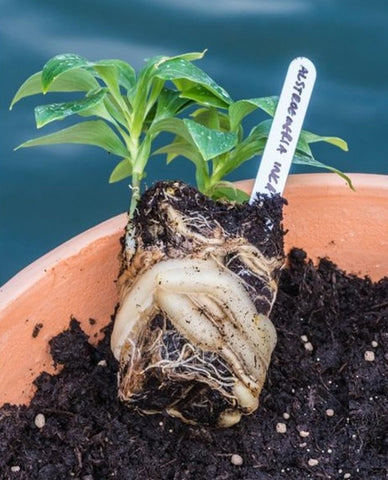It's All About the Roots

Importance of Healthy Root Structure
I get funny looks when I shop at the garden center. I think it is when I tip the plant out of its pot to get a good look at the roots before I decide which to buy. But this is absolutely key to determining the health and vitality of the plant for sale. Disregard the lush top growth and number of flowers. To evaluate the health and long term performance of a plant - it is all about the roots.

We tend to value plants for their top growth. It is the part we can see, and that adds beauty to our garden and home. But lush leaves and beautiful blooms all come up from the roots.
What Do Roots Do?
The roots of a plant have several important functions. The roots anchor the plant in place, resisting the forces of wind and running water or mud flow. The root system takes in oxygen, water and nutrients from the soil, to move them up through the plant to the stems, leaves and blooms. Roots often store the energies created by the plant through photosynthesis, to make them available to the plant as it is needed. Plant roots also stimulate and support microorganisms in the soil that benefit plant life.
Another way to describe the work of the plant's roots is in relation to us. Plant roots prevent soil erosion, feed the development of food and beauty, and directly provide our nourishment. Carrots, turnips, beets and many more are excellent examples of roots that store plant developed energies. We often plant crops for the purpose of rehabilitating depleted soils for future crop production.
Don't Discard that Plant
Stress is a part of life. When a plant is stressed, due to extreme temperatures, unusual amounts of drought or water, animal predation or disease, it will show in the plant's leaves. Limp or yellow leaves can indicate that a plant has been exposed to stressful conditions. But just like people and pets, plants can recover from stress to lead long and production lives. How to know if your plant will recover? Take a look at those roots. Healthy roots make a healthy plant. And healthy plants recover from stress.
Some plants actually develop particularly brittle leaves and stems to allow the plant to easily sacrifice top growth to herbivores or stress while protecting their all-important root structure. Both grass and dandelions easily tolerate munching herbivores or lawn mower blades, rapidly producing fresh foliage to replace what is lost, while their root structure is extremely resistant to harm, thereby ensuring a long life for both the lawn and the weed.
Alstroemeria are a great garden example similar to these plants. Alstroemeria produce lush foliage and loads of flowers for months at a time. These flower factories are powered by extraordinary root structures that enable them to be highly adaptable in the home garden. The stress of too much or too little water, high heat, foot traffic, fire or even being shipped can cause the top growth of alstroemeria to yellow and go limp. Far from damaging the health of the plant, this is a strategy the plant has developed to survive stressful conditions. Yellow and/or limp leaves do not pull the resources of water and food that healthy leaves do. This allows the plant to conserve its energies to quickly replenish the damaged top growth with a flush of new leaves and blooms once the stressful conditions have passed.

Here, we can see the exceptional root structure of an alstroemeria plug. The super thick roots are storing energy for the plant's future needs, while the finer roots take up water and nutrients to feed the plant's current top growth.
If your alstroemeria plant looks like this, with dark green leaves and a robust root ball, loosen the roots to help them to spread out in the new location, then transplant it to a new pot or the ground with loose, nutritious soil. Do not plant the roots too deep - maintain the same level as the soil on the plug or in the pot. Firm the soil around the root ball and water it in.
If the top growth looks bruised or limp or yellow, simply pinch the top growth right back to the soil line, and plant it as above. Many plants respond more quickly to replace top growth that has been removed rather than to rejuvenate damaged leaves left attached. This is certainly true for alstroemeria. Look for a flush of new growth to replace the yellowed leaves quickly upon being pinched back.
Signs of poor or damaged roots will lead to an unhealthy plant with a short life and limited blooms - no matter what the plant looks like right now. Sparse roots relative to the normal root ratio for that type of plant, shriveled roots, mushy or highly brittle roots, or those that lie limply in the soil, rather than holding on to the surrounding soil matrix are examples of root structures that are damaged and spell doom for the plant.
There are a few causes that can result in such poor roots, but excess water in the soil is far and away the most common culprit. Excessive moisture together with warm temperatures can lead to root rot, which is death for a plant. If you have ever tried to transplant a plant with beautiful leaves and blooms, only to have the plant pull away without its roots, then you have met root rot. Some plants react to dying roots by using their last energies to produce extras blooms, in the hope of reproducing before death. These plants can look terrific - for a short time only.
Everything we love about our plants are the result of healthy roots. Flowers, fragrance, lush foliage, fruit - all are dependent upon the health and vitality of the plant, which is dependent on the root structure. So, the next time you are out shopping for plants - will you be tipping them out of their pots to check out their roots? I'll see you there! :)
Happy Gardening!

- Tags: Tips
- Kathleen McCarthy
